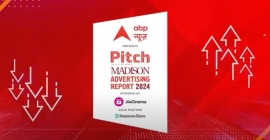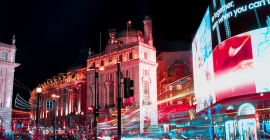Can the Elephant befriend the Dragon?
By M4G Bureau - July 11, 2017
More than 50% of OOH media in China comprises digital (LED) displays. And these come in all formats, sizes and shapes.
IOAA was invited to participate in the 14th China OOH Communication Conference, held in Zheng Zhou, China on May 25 to 27, 2017. Indrajit Sen represented IOAA and presented about India and opportunities that exist for OOH businesses in India and China to work together. Outdoor Asia spoke to Sen about his learnings and observations from this trip. Edited excerpts:
What is the Chinese OOH industry all about? Any similarities with the Indian OOH industry?
The Chinese OOH industry revenue is about 15X that of Indian OOH industry’s revenues. That would give context to the whole discussion. China has closely followed Europe and North America in opting out of print advertising media – OOH is the third largest media after TV and Digital, with 11% share of the pie. In India, the figure is about 5.5%. In fact, print brands have shifted to OOH media and offer newspapers for free public reading in innovatively designed roadside panels which has the top half as LED panels and newspaper pages displayed at the bottom at eye level.
More than 50% of OOH media in China comprises digital (LED) displays. And these come in all formats, sizes and shapes. This improves the quality of display enormously and makes it visually very attractive. On the whole, cities look very vibrant with OOH displays at all levels – street furniture to giant wallscapes made from LED modules.
Licensing is far more controlled than in India though complaints of individual bias and ad hoc allotments and cancellations are also heard quite loudly. But these are few cases – exceptions not the rule. Downtown – shopping, commercial and business areas -- permit OOH everywhere. Locations reduce as one moves to Government office areas and to residential areas. Highways also appeared to be largely free of displays – depending upon the policy of the local district / area administration. Despite complaints, violations are few as regulations are strictly implemented in most places – exceptions are individual cases and definitely not rampant. This has actually benefited the industry by controlling supply so that values per unit are maintained at a level which raises the whole revenue levels of the industry.
One point of similarity between China and India is that media ownership is highly fragmented – more than 1,500 media owners operate in China. However, I did meet a few media owners who have large holdings; one in particular has networked sites across more than 200 towns and villages and has the largest share in upcountry & rural China. Their entire network works on manual controls and networking – something to definitely learn about.
While on one hand a number of companies are listed on the stock exchanges, and have received PE investments, on the other hand, none of the companies that I came across said they operated with software based management systems. Though mobile & smart phones are as common as people, with everyone using them extensively, their use in managing enterprises appears to be very limited and maybe in other industries – not in OOH.
Did you spot any significant opportunities for Indian companies to engage with Chinese OOH businesses?
The Indian Government is encouraging both digitisation and adoption of DOOH-led advertising to create smart city infrastructure and public services in a very focussed manner. Various infrastructure projects are now coming up in different parts of the country. Railways (2nd largest railway network in the world), Metros in all large cities, Expressways and Highways across the country, airports, are all being implemented as we speak. All of this needs extensive DOOH networks to be established.
In India, we are already sourcing digital (LED) systems from China. However, our usage at present is extremely limited due to high prices and one year to 3 years licensing periods. However, this is changing – licensing periods are up to 10 years at both railways and airports. Municipalities will soon follow. Rates are already getting lower by the year. There are efficient, proven suppliers who are prepared to participate in JV with investments in LED display systems being paid off from revenues generated over a period of time.
Indian companies who want to expand their businesses to take advantage of Government policies also have an opportunity to enter into partnerships with large Chinese OOH businesses who have extensive experience in railways, metros, roadways as well as infrastructure / service oriented advertising. All they need is to learn from and utilise existing expertise of the Chinese companies in both creating quality display assets and extending experiences with multinational brands in China to their counterparts in India. This is bound to lead to a win-win proposition for both large OOH businesses in India and China.
End of the day, India and China are two of the biggest populations and, consequently, among the biggest markets in the world today and in foreseeable future. This is one factor that simply cannot be wished away. Add to that the fact that 60%+ of India’s population will hover below 35 years of age for a long time to come now. All this makes for a very attractive market for all kinds of products and brands. Now, while the market pioneers are multinational brands from advanced economies, the next set of brands in nearly all categories are indigenous ones. In the past as well as currently, the clout of the multinational brands operating through international agencies, have kept media spends low in our countries as compared to the traditional markets of Europe and North America. And if India and China continue to face these spenders separately, neither will really gain space in the larger context. But if an OOH budget is offered by a group that markets assets across both the countries, just imagine the bargaining clout that results and the shift in negotiating balance that inevitably has to follow.
Then consider the indigenous brands: these will gain much better access if media in each country is better accessed than at present by the other. This will provide further leverage for our domestic indigenous brands which – in turn – flows back to strengthen revenue base of the media.
I believe this needs to be carefully evaluated and extensively discussed by large businesses in both countries; working out marketing JVs amongst companies owning large number of assets in each country, may be the way to go.
Any foreseeable barriers to achieve JV results?
This is an easy question to answer – the same old factors. Evaluation of skills, achievements, intentions and attitudes on both sides to see how much of a match exists. Obviously, there will be skill / capability / resource gaps at each end which the other can fulfil. One large issue in this evaluation will be language – not much English is spoken in China but enough to get work done by getting suitable persons involved -- and that is solved easily. Other than this, the only other barrier can really come from Government policies. Besides that, I believe even funding institutions will find JVs between Indian and Chinese companies a lower risk and a viable investment – because of the larger market spread and opportunities in both markets as well as the scale of operations.
Is China's digital OOH experience relevant to the India OOH industry?
China’s widespread digital OOH presence proves that the initial “beta” phase of testing and trials are long over and you have stable products. The very large variety of installations also prove that Chinese designers have mastered installations at various locations and sizes. All this makes the Chinese digital equipment and process suppliers quite an attractive source. Finally, if this is bundled with a flexible and innovative pricing mechanism, the packaging would be absolutely complete. In a fast growing market, often implementing a plan in a projected time span is the biggest issue due to unforeseen glitches, especially in high technology areas. In such cases, partnering with an experienced supply source is the best solution for staying within budgets and overcoming commissioning issues promptly. So – great experience and great pricing – both appear to be on offer by Chinese digital businesses – it is obviously a plus for India – which needs these in large numbers.
Do you think India's software know-how can be a benefit to the Chinese market?
India’s software expertise is proven globally. As such, software-driven enterprise resource planning (ERP) systems have been in operation in the OOH industry in India for a long time now. This has helped in increasing efficiency and lowering costs of inventory management, asset creation & licensing, sales, billing, HR management, accounts and finance management. There are both separate, specialised software for different functions as well as integrated tailor-made software systems for larger companies. In fact, a large number of businesses that have substantial revenues, already operate with such software based systems.
Larger the spread of the business, more difficult it becomes to manage the asset inventory and the other functions in an optimal manner with only manual processes. Implementing a software-based process can free a number of people who may then be engaged in more profitable activities after re-training / re-skilling. As such, our software companies that are working for the OOH industry are likely to find a ready and large market in China with language being the only issue to be really solved.
If Indian and Chinese OOH companies start working together, where do you think that can go?
OOH & DOOH advertising media is a reflection of the economic status of the country or region. This is because this media – and only this media – has no other reason to exist except to serve marketing communication needs of brands that are in the marketplace. If brands have less to spend on advertising because of economic conditions, then it creates vacant OOH media and immediately tells its story. The other way around is also equally true. Given the current economic status of India and China and projections for future, continued growth of OOH / DOOH in these two countries is inevitable.
Though markets in both China and India are penetrating increasingly into upcountry areas, villages and small towns, bulk of brand communications is in urban areas still and likely to be there in future too. Urban areas are increasingly beginning to look alike – structurally … there will always be cultural, geographical and historical differences but in all major cities across both countries – and, indeed, most of the world today, you will see a “downtown” area, business district, metro, public bus system, airport at the edge of the city, residential and shopping areas quite well defined. On roads, foot-overbridges or underpasses, bus shelters, street furniture are also common features. So, cities are beginning to feel similar and will increasingly feel so in future. OOH / DOOH display systems can increasingly be standardised across different formats making production more cost optimised and installing campaigns across markets much easier. Provided, we have businesses in both markets that decide to work together.
Next is the progress of personal communication devices – already, statistics show that smart phone users check their screens an average of 86 times a day. This will only increase with time. This has already led to development of beacons to connect an OOH ad with mobile / smart phone passing by and carry the ad message home. There are other devices in development stages which identify history of user through their mobile phones and directs change of image on the nearest OOH display to match mobile owners’ preferences. Recall “Minority Report”. Science fiction is fast becoming reality.
So, how does all of this add up to prospects for the OOH & DOOH businesses in India and China?
China has mastered LED displays. India has mastered software development. If the larger businesses in both India and China can overcome egos, and other minor issues like language barriers, to come together, developments to move to the next generation OOH display technology will happen in our part of the world. Both revenues and values will automatically flow.
The similarities in urban areas need to be leveraged to spread OOH advertisement displays easily and uniformly. This will encourage R&D especially in technology-led areas.
There needs to be a day in the next 10 years when the world will come to either India or China to take part in an Expo to check out the most innovative and latest generation OOH displays showcased by Indian-Chinese JV companies.

Stay on top of OOH media trends





